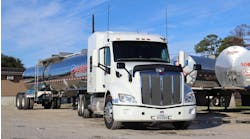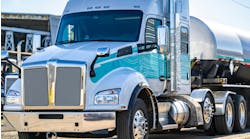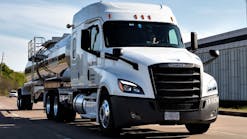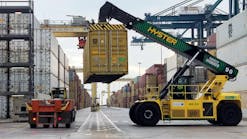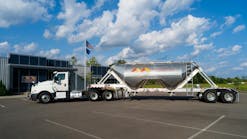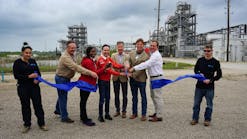THE revised API 2350 Standard will require changes in the way terminals operate, according to Charlie Lewis, director of technical services for TransMontaigne Product Services Inc.
Changes start with the terminology. The new API 2350 describes the Overfill Prevention Process (OPP): “When receiving product into a tank, the flow is terminated prior to the tank level reaching the Critical High (CH) level.”
Lewis said terminated means: terminating the source of pressure (shutting down a pump); diverting the incoming flow; shutting down the flow by closing the valves; or using an alternate method to bring a receipt to a safe state.
“I think a lot of times in terminals we say, ‘stop,’ ” he said. “This document is big on terminology. The terms we have out there today aren’t necessarily what this document is calling them.”
There are changes in the standard regarding the management system. Risk assessment involves categorizing risks with potential tank overfill.
“What they’re really saying is that back in the old days, you based levels and alarms on 10-minute or five-minute time frames,” Lewis said. “Now, they want you to start thinking about what other things are involved. Is the tank across the road over a railroad track? How long would it take me to get there?”
“High Tank Level” is a term no longer used. “Safe Fill Height” is no longer used, replaced by “High High Tank Level.” “Critical High” replaces “Overfill Level,” and “Maximum Working Level” replaces “Normal Fill Height.”
“Communication will be very important, especially when we need these terms in emergency situations,” he said. “You always fall back to what you know. “
He said API 2350 does not specify how, but what to implement:
• Documented operating procedures, including safety and emergency response procedures.“They really want you to focus on, if you have a pipeline connection, you have to communicate with them in much deeper way. You see a lot more communication involved in this.”
• Competent operations personnel.“Training!”
• Competent technical personnel.“This has to be all documented. Does the operator know how to go out and test? Did he sign off? Did you train him?”
• Scheduled inspection and maintenance program. “They actually want a program and documented steps.”
• Management of Change process (MOC).“If you change the MOC program, you have to document it. And you have to document why, from the technical staff to operations staff.”
• A system to identify, investigate, and communicate near misses.“So if something goes wrong, they want you to sit down and think about, ‘What did we do good? What did we do bad?’ ”
He said API 2350 does not specify how to implement risk assessment, but it helps with criteria.
“The biggest thing they want you to look at is to reduce tank overfills by looking at all factors surrounding the tank—because only you know what’s going on,” he said. “The focus of assessment is to reduce tank overfills. It’s site-specific, for each tank. A complete risk assessment for any possible product flow to and from a tank includes all associated processes. The gist of things is, ‘We’re not going to be solely based on times. It’s, what could possibly affect it?’ Don’t forget your inventory requirements. What if you have a secondary tank requirement?
“Consider flow-rate changes, valve-lineup paths, tank-to-tank transfers, offloading, marine/over-the-water risks. Don’t forget to consider any other regulatory requirements, such as secondary containment requirements.”
API 2350 requires that each tank be categorized into three groups that make it easier to evaluate the existing tank-gauging configuration on each tank. The standard does not state which category is best, but it is understood that the higher the category, the more reliable the tank-gauging system is:
• Category 1: All operations are performed manually by a local operator. A person is required to be by the tank to shut the valve during a receipt in order to prevent an overflow. There are no transmittable alarms, and it is entirely up to the operator to know when a high level has been reached.
• Category 2: The tank is equipped with sensors and alarms to notify personnel of a high level, so operators don’t have to be right by the tank to determine if there is an overfill risk. Since the sensors and alarms can transmit level information, an operator may be able to cancel a receipt by closing the valve remotely from a control room.
• Category 3: The tank is equipped with an independent, high-level alarm. This category is theoretically more reliable because it has a backup sensor to mitigate the failure of the primary one.
The Automatic Overfill Prevention System (AOPS) is separate from the first three categories. The AOPS is never intended to be used on its own, but in addition to one of the other configurations (usually Category 2 or 3). Sometimes AOPS is referred to as Category 4. AOPS is capable of executing a shutoff without human intervention.
He said Levels of Concern (LOC) are theoretical liquid-level positions that are important to the operation of a tank. API 2350 requires operators to define LOCs and equip them with the appropriate alarms:
• Critical high (CH): The level point where an overflow occurs. An alarm is not required because it would be too late to take action if activated.
• High high (HH): The only level point where an alarm is required by the standard. It plays a key role in the response time.
• Maximum working level (MW): This should be the highest level point under normal conditions, and is the target for a full tank.
He said that to pinpoint where the HH alarm should be located, a good understanding of the rate of the rising liquid is necessary, and this should be documented for each tank.
API 2350 allows an operator to determine his own response times, but will require extensive documentation. For Category 1 tanks, the minimum response time is 45 minutes; for Category 2 tanks, 30 minutes; and for Category 3, 15 minutes.
“With more equipment on the tank, you can fill faster and have shorter response times,” he said. “Once LOCs are established, there should be periodic reviews, with a five-year maximum between. Be mindful of tank modifications, such as in API 653. Do they change your LOC setting?”
Johan Sandberg, global sales manager for Rosemount Tank Gauging, said the benefits of API 2350 are self-explanatory.
“There’s a reduced risk of flammable liquids,” he said. “You can avoid unplanned downtime. And it reduces the cost of insurance if proper measures are being taken. There’s also efficiency. Proper equipment can increase the transfers.”
He said the management system’s benefits are accentuated by an accident in the United Kingdom eight years ago in which a tank-gauging system failed 14 times before the accident happened.
“No action was done to take care of that particular problem, and that was a key element,” he said. “A good management system can take care of this. You can have something happening that would jeopardize the operation, and you would have to have routines to prevent that.
“In the area of tank storage, the risk could be a change in operating parameters like changing the flow rates to tanks, or it could be a change in the operating procedures and practices, like more people at the site. It could also mean a change of all equipment on tanks.”
He said he always advocates Category 3 systems because “all things being equal, the more equipment you have, the safer the device will become. But of course, that depends on the risk assessment you make for this particular tank operation.” ♦
